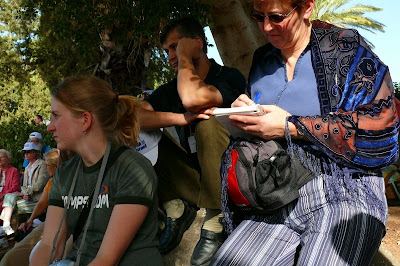
This looked like a bomb shelter








 Mount Tabor
Mount Tabor
 In Tabgha, on the sea of Galilee, they remember the miraculous feeding with the loves and the fishes.
In Tabgha, on the sea of Galilee, they remember the miraculous feeding with the loves and the fishes.  St. Peter's fish. This was the kind of fish from the story in Matt 17. In this account the fish had swallowed a coin, which Peter used to pay the temple tax for Jesus and himself. The temple tax was required for all males over the age of 20. This gives you a different idea of how old the disciples would have been (only Jesus and Peter had to pay).
St. Peter's fish. This was the kind of fish from the story in Matt 17. In this account the fish had swallowed a coin, which Peter used to pay the temple tax for Jesus and himself. The temple tax was required for all males over the age of 20. This gives you a different idea of how old the disciples would have been (only Jesus and Peter had to pay). These dates were big and tasted very good.
These dates were big and tasted very good.






 Caesarea Phillipi was a very pagan place. This was where the fertility shepherd god Pan was worshiped. It must have been an impressive sight. It was a huge temple. The hollow niches in the wall were where the statues of the god were.
Caesarea Phillipi was a very pagan place. This was where the fertility shepherd god Pan was worshiped. It must have been an impressive sight. It was a huge temple. The hollow niches in the wall were where the statues of the god were. Water came out of the cave (out of the rock) behind the temple . This water is a source of the Jordan river.
Water came out of the cave (out of the rock) behind the temple . This water is a source of the Jordan river.

 Jo started with a moment of "Stika" (36 seconds of quietness), to hear God's spirit ("Ruach"). He told us that Jesus came to heal our upside-down world. He came to make it right again.
Jo started with a moment of "Stika" (36 seconds of quietness), to hear God's spirit ("Ruach"). He told us that Jesus came to heal our upside-down world. He came to make it right again. Dvora told us about all all of the "other" cities in the area - the ones that we've never heard of. The reason we don't know about them is because Jesus didn't go there.
Dvora told us about all all of the "other" cities in the area - the ones that we've never heard of. The reason we don't know about them is because Jesus didn't go there.
